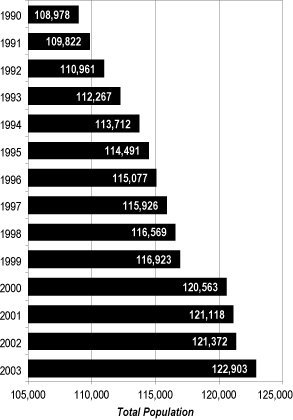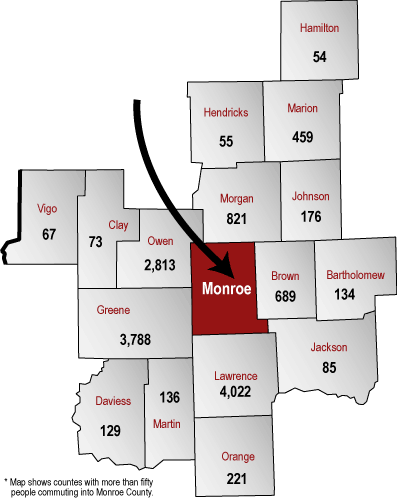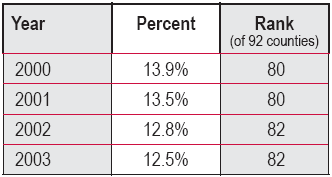Bloomington
President, Strategic Development Group, Inc., Bloomington
In many ways, Bloomington is transitioning. The most obvious evidence of change is downtown. Like mushrooms after a spring rain, the new apartments lining downtown streets are changing the skyline and nature of downtown Bloomington.
Economically, this has been a mixed year for Bloomington and Monroe County. However, the community remains one of the economic leaders in the state. This is an economy in transition; however, it is not clear what Bloomington’s economy is transitioning into.
Let’s look at three factors that suggest the health of the Bloomington economy:
- Population: We are growing but our growth rate has slowed. Population growth has increased in neighboring counties.
- Employment: We continue to lose traditional manufacturing jobs (although we will see ups and downs in this sector); these jobs are being replaced by service sector jobs.
- Income: The challenge will be to grow new economy manufacturing and service sector jobs sufficiently to replace the high-paying manufacturing jobs that we have lost and will continue to lose.
Population
In terms of population change, Monroe County continues to grow. In recent years, the growth rate has slowed somewhat from the previous twenty years, but the population still is growing (see Figure 1).
Figure 1
Monroe County’s Population, 1990 to 2003

The county’s population growth rate between 1990 and 2003 is above the state average. Although between 2000 and 2002 the county’s growth rate (0.6 percent) was lower than the state average (1.3 percent). However, looking at the whole Bloomington metro area, which includes Greene and Owen counties, we ranked ninth among sixteen metro areas in the state.
However, we have not kept up with the population growth leaders in the state. Monroe County was the eleventh most populous Indiana county in 1990; today we are the twelfth most populous.
Commuting Patterns for Monroe County
With a residential labor force of 66,289, the community is also important to the economies of Greene, Owen and Lawrence counties. This residential labor force has remained stable. Bloomington continues to serve as a regional employment center, as nearly 15,000 workers commuted to Monroe County to work, according to Census 2000 (see Figure 2).
Figure 2
Workers 16 and Older Commuting into
Monroe County, 2000*

Monroe County’s unemployment rate is regularly among the lowest in the state. In September 2004, the county’s unemployment rate was 2.5 percent.
Employment
While employment has remained strong in Bloomington, the nature of that employment is changing. After years of manufacturing employment expansion, manufacturing employment in the county has shrunk over the past several years. As of 2003, the manufacturing sector represented just 12.5 percent of Monroe County employment (see Table 1).
Table 1
Monroe County Manufacturing
Employment as a Percent of All Jobs

For the past several years, Bloomington has been a leader in an economic transition. We continue to lose traditional manufacturing jobs and gain jobs in less traditional manufacturing areas and in the service sector. We actually gained manufacturing jobs between 2002 and 2003. But overall, we have had a net loss of about 1,500 manufacturing jobs between 1994 and 2003. The job losses will probably continue in manufacturing, with a number of jobs likely to be lost in the next twelve months.
However, the decline of manufacturing employment is not a simple issue. For example, one manufacturing company in Bloomington is in the middle of an expansion that projects 250 new jobs. And the life sciences manufacturing sector has great promise here.
Despite the substantial loss of manufacturing employment, Bloomington’s economy has remained relatively stable. The community has partly compensated for the loss of manufacturing employment with the growth of service and government jobs.
The community is seeing strong small business growth in sectors such as information services and life sciences. For example, the health care and social services sector now makes up approximately 10 percent of the county’s employment, with average earnings per job exceeding $36,000 per year. Information and professional technical services accounts for approximately 6 percent of the county’s workforce, based on 2002 data, with average earnings per job between $30,000 and $49,000.
The government sector (this includes employment at Indiana University) now accounts for approximately 25 percent of the employment base, and service sector jobs make up over 25 percent of the employment base in Monroe County.(1) Wages from government in 2002 totaled approximately $731 million.
Bloomington continues to be an economy in transition. The community remains a regional locus of manufacturing, but the growth in higher-wage employment appears to be coming from the government and service sectors. It will be interesting to see if the Bloomington experience reveals a new approach to the Indiana economy: retain a core manufacturing base but grow the overall economy through higher-paying jobs in education and service.



